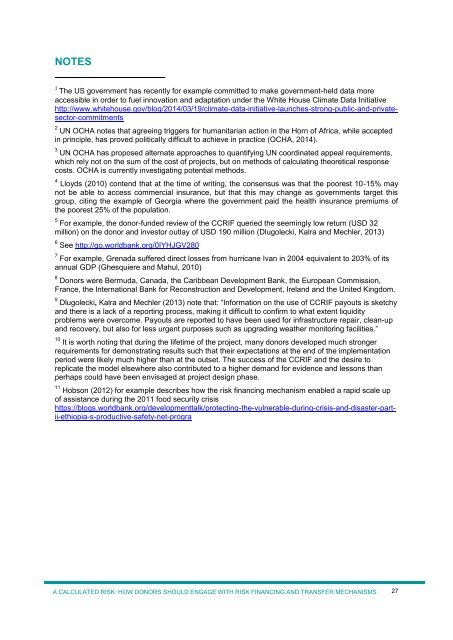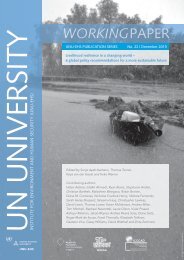k5q82a3
k5q82a3
k5q82a3
Create successful ePaper yourself
Turn your PDF publications into a flip-book with our unique Google optimized e-Paper software.
NOTES<br />
1 The US government has recently for example committed to make government-held data more<br />
accessible in order to fuel innovation and adaptation under the White House Climate Data Initiative<br />
http://www.whitehouse.gov/blog/2014/03/19/climate-data-initiative-launches-strong-public-and-privatesector-commitments<br />
2 UN OCHA notes that agreeing triggers for humanitarian action in the Horn of Africa, while accepted<br />
in principle, has proved politically difficult to achieve in practice (OCHA, 2014).<br />
3 UN OCHA has proposed alternate approaches to quantifying UN coordinated appeal requirements,<br />
which rely not on the sum of the cost of projects, but on methods of calculating theoretical response<br />
costs. OCHA is currently investigating potential methods.<br />
4 Lloyds (2010) contend that at the time of writing, the consensus was that the poorest 10-15% may<br />
not be able to access commercial insurance, but that this may change as governments target this<br />
group, citing the example of Georgia where the government paid the health insurance premiums of<br />
the poorest 25% of the population.<br />
5 For example, the donor-funded review of the CCRIF queried the seemingly low return (USD 32<br />
million) on the donor and investor outlay of USD 190 million (Dlugolecki, Kalra and Mechler, 2013)<br />
6 See http://go.worldbank.org/0IYHJGV280<br />
7 For example, Grenada suffered direct losses from hurricane Ivan in 2004 equivalent to 203% of its<br />
annual GDP (Ghesquiere and Mahul, 2010)<br />
8 Donors were Bermuda, Canada, the Caribbean Development Bank, the European Commission,<br />
France, the International Bank for Reconstruction and Development, Ireland and the United Kingdom.<br />
9 Dlugolecki, Kalra and Mechler (2013) note that: “Information on the use of CCRIF payouts is sketchy<br />
and there is a lack of a reporting process, making it difficult to confirm to what extent liquidity<br />
problems were overcome. Payouts are reported to have been used for infrastructure repair, clean-up<br />
and recovery, but also for less urgent purposes such as upgrading weather monitoring facilities.”<br />
10 It is worth noting that during the lifetime of the project, many donors developed much stronger<br />
requirements for demonstrating results such that their expectations at the end of the implementation<br />
period were likely much higher than at the outset. The success of the CCRIF and the desire to<br />
replicate the model elsewhere also contributed to a higher demand for evidence and lessons than<br />
perhaps could have been envisaged at project design phase.<br />
11 Hobson (2012) for example describes how the risk financing mechanism enabled a rapid scale up<br />
of assistance during the 2011 food security crisis<br />
https://blogs.worldbank.org/developmenttalk/protecting-the-vulnerable-during-crisis-and-disaster-partii-ethiopia-s-productive-safety-net-progra<br />
A CALCULATED RISK: HOW DONORS SHOULD ENGAGE WITH RISK FINANCING AND TRANSFER MECHANISMS<br />
27



